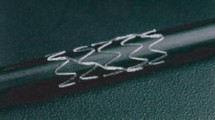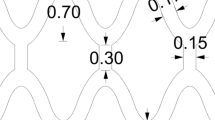Abstract
Bioresorbable vascular scaffolds were considered the fourth generation of endovascular implants deemed to revolutionize cardiovascular interventions. Yet, unexpected high risk of scaffold thrombosis and post-procedural myocardial infractions quenched the early enthusiasm and highlighted the gap between benchtop predictions and clinical observations. To better understand scaffold behavior in the mechanical environment of vessels, animal, and benchtop tests with multimodal loading environment were conducted using industrial standard scaffolds. Finite element analysis was also performed to study the relationship among structural failure, scaffold design, and load types. We identified that applying the combination of bending, axial compression, and torsion better reflects incidence observed in-vivo, far more than tranditional single mode loads. Predication of fracture locations is also more accurate when at least bending and axial compression are applied during benchtop tests (>60% fractures at connected peak). These structural failures may be initiated by implantation-induced microstructural damages and worsened by cyclic loads from the beating heart. Ignoring the multi-modal loading environment in benchtop fatigue tests and computational platforms can lead to undetected potential design defects, calling for redefining consensus evaluation strategies for scaffold performance. With the robust evaluation strategy presented herein, which exploits the results of in-vivo, in-vitro and in-silico investigations, we may be able to compare alternative designs of prototypes at the early stages of device development and optimize the performance of endovascular implants according to patients-specific vessel dynamics and lesion configurations in the future.








Similar content being viewed by others
References
Ali, Z. A., R. Gao, T. Kimura, Y. Onuma, D. J. Kereiakes, S. G. Ellis, B. Chevalier, M. T. Vu, Z. Zhang, C. A. Simonton, P. W. Serruys, and G. W. Stone. Three-year outcomes with the absorb bioresorbable scaffold. Circulation 137:464–479, 2018.
Ang, H. Y., Y. Y. Huang, S. T. Lim, P. Wong, M. Joner, and N. Foin. Mechanical behavior of polymer-based vs. metallic-based bioresorbable stents. J. Thorac. Dis. 9:S923–S934, 2017.
ASTM International. ASTM F2606-08: Standard Guide for Three-Point Bending of Balloon Expandable Vascular Stents and Stent Systems. 2008.
ASTM International. Standard Test Methods for in vitro Pulsatile Durability Testing of Vascular Stents. 2013.
Bergström, J. S., and D. Hayman. An overview of mechanical properties and material modeling of polylactide (PLA) for medical applications. Ann. Biomed. Eng. 44:330–340, 2016.
Byrne, R. A., G. G. Stefanini, D. Capodanno, Y. Onuma, A. Baumbach, J. Escaned, M. Haude, S. James, M. Joner, P. Jüni, A. Kastrati, S. Oktay, W. Wijns, P. W. Serruys, and S. Windecker. Report of an ESC-EAPCI Task Force on the evaluation and use of bioresorbable scaffolds for percutaneous coronary intervention: Executive summary. EuroIntervention 13:1574–1586, 2018.
Cheng, Y., P. Gasior, K. Ramzipoor, C. Lee, J. C. McGregor, G. B. Conditt, T. McAndrew, G. L. Kaluza, and J. F. Granada. In vitro mechanical behavior and in-vivo healing response of a novel thin-strut ultrahigh molecular weight poly-L-lactic acid sirolimus-eluting bioresorbable coronary scaffold in normal swine. Int. J. Cardiol. 286:21–28, 2019.
Choi, G., C. P. Cheng, N. M. Wilson, and C. A. Taylor. Methods for quantifying three-dimensional deformation of arteries due to pulsatile and nonpulsatile forces: implications for the design of stents and stent grafts. Ann. Biomed. Eng. 37:14–33, 2009.
Choi, G., G. Xiong, C. P. Cheng, and C. A. Taylor. Methods for characterizing human coronary artery deformation from cardiac-gated computed tomography data. IEEE Trans. Biomed. Eng. 61:2582–2592, 2014.
Ding, Z., H. Zhu, and M. H. Friedman. Coronary Artery Dynamics in-vivo. Ann. Biomed. Eng. 30:419–429, 2002.
Dreher, M. L., S. Nagaraja, and B. Batchelor. Effects of fatigue on the chemical and mechanical degradation of model stent sub-units. J. Mech. Behav. Biomed. Mater. 59:139–145, 2016.
Kolandaivelu, K., and F. Rikhtegar. The Systems Biocompatibility of Coronary Stenting. Interv. Cardiol. Clin. 5(3):295–306, 2016.
Liao, R., N. E. Green, S.-Y. James Chen, J. C. Messenger, A. R. Hansgen, B. M. Groves, and J. D. Carroll. Three-Dimensional Analysis of in-vivo Coronary Stent—Coronary Artery Interactions. Int. J. Cardiovasc. Imaging 20:305–313, 2004.
Qiu, T., R. He, C. Abunassar, S. Hossainy, and L. G. Zhao. Effect of two-year degradation on mechanical interaction between a bioresorbable scaffold and blood vessel. J. Mech. Behav. Biomed. Mater. 78:254–265, 2018.
Schmidt, W., P. Behrens, C. Brandt-Wunderlich, S. Siewert, N. Grabow, and K. P. Schmitz. In vitro performance investigation of bioresorbable scaffolds—Standard tests for vascular stents and beyond. Cardiovasc. Revasc. Med. 17:375–383, 2016.
Serruys, P. W., B. Chevalier, Y. Sotomi, A. Cequier, D. Carrié, J. J. Piek, A. J. Van Boven, M. Dominici, D. Dudek, D. McClean, S. en Helqvist, M. Haude, S. Reith, M. de Sousa Almeida, G. Campo, A. Iñiguez, M. Sabaté, S. Windecker, and Y. Onuma. Comparison of an everolimus-eluting bioresorbable scaff old with an everolimus-eluting metallic stent for the treatment of coronary artery stenosis (ABSORB II): a 3 year, randomised, controlled, single-blind, multicentre clinical trial. Lancet 388:2479–2491, 2016.
Sotomi, Y., P. Suwannasom, P. Serruys, and Y. Onuma. Possible mechanical causes of scaffold thrombosis: insights from case reports with intracoronary imaging. EuroIntervention 12:1747–1756, 2017.
Wang, P. J., N. Ferralis, C. Conway, J. C. Grossman, and E. R. Edelman. Strain-induced accelerated asymmetric spatial degradation of polymeric vascular scaffolds. Proc. Natl. Acad. Sci. U.S.A. 2018. https://doi.org/10.1073/pnas.1716420115.
Wang, P. J., F. R. Nezami, M. B. Gorji, F. Berti, L. Petrini, T. Wierzbicki, F. Migliavacca, and E. R. Edelman. Effect of working environment and procedural strategies on mechanical performance of bioresorbable vascular scaffolds. Acta Biomater. 82:34–43, 2018.
Acknowledgments
The authors gratefully thank Boston Scientific Corporation (Marlborough, MA) for partial grant support and generous supply of test specimens and scaffolds, and the supports of animal studies. Elazer R Edelman, Pei-Jiang Wang, and Farhad Rikhtegar Nezami were supported in part by National Institutes of Health (R01 49039). Francesca Berti and Francesco Migliavacca were partially supported by the Fondazione Fratelli Agostino and Enrico Rocca through a “Progetto Rocca” doctoral fellowship. Francesca Berti, Luca Antonini, Lorenza Petrini, and Francesco Migliavacca are partially supported by the European Project INSILC.
Conflict of interest
The authors declare that there are no conflict of interests regarding the publication of this article.
Author information
Authors and Affiliations
Corresponding author
Additional information
Associate Editor Estefanía Peña oversaw the review of this article.
Publisher's Note
Springer Nature remains neutral with regard to jurisdictional claims in published maps and institutional affiliations.
Rights and permissions
About this article
Cite this article
Wang, PJ., Berti, F., Antonini, L. et al. Multimodal Loading Environment Predicts Bioresorbable Vascular Scaffolds’ Durability. Ann Biomed Eng 49, 1298–1307 (2021). https://doi.org/10.1007/s10439-020-02673-z
Received:
Accepted:
Published:
Issue Date:
DOI: https://doi.org/10.1007/s10439-020-02673-z




